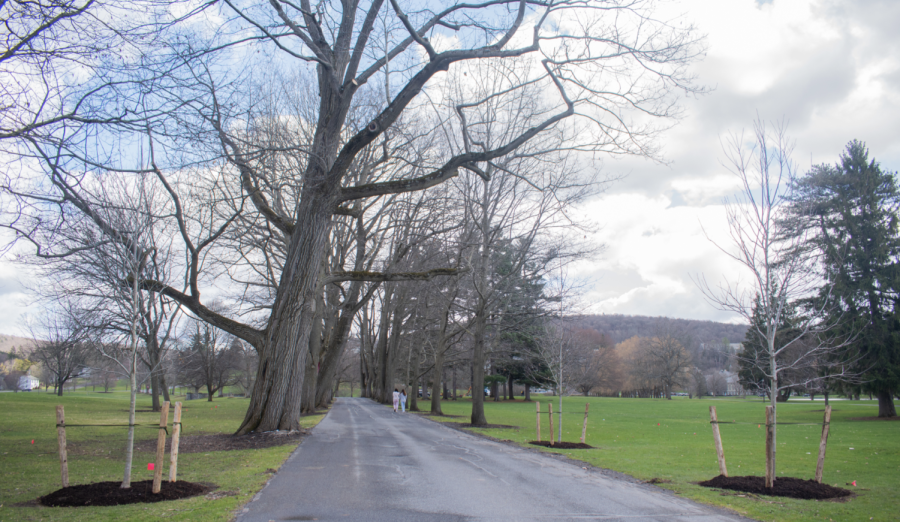Oak Drive Restoration, Expansion Closes the Tree-Lined Road Sporadically Throughout April
Construction crews have lined Oak Drive over the last two weeks as the hallmark tree-lined road leading from Broad Street to campus undergoes a restoration project after an arborist Colgate brought in to assess two splitting trees found that eight more were in dangerous condition. Along with the removal of hazardous trees that took place over winter break, the restoration project will also add more trees along the road, extending Oak Drive, a project that has closed its entrance to campus sporadically since April 7 and through April 29, according to a recent broadcast message.
According to Colgate University President Brian Casey, addressing the trees deemed dangerous was the immediate first step in the restoration project, a decision informed by the arborist’s caution that “when a tree comes down in a snowstorm it comes down fast and it can kill people,” Casey said. After the removal of these during winter break, the next stage in the restoration will fulfill Casey’s vision for an expanded and upgraded Oak Drive that will add 68 new trees to the road and add an extension towards Hamilton Street with lighted, tree-lined walking pathways.
“I’m committed to planting more trees,” Casey said. “I think students know I like trees, so all of Oak Drive… is [going to] go all the way to the corner — all new lights, new pathways — and an alum is paying for it.”
Oak Drive’s current alignment was established and oak trees were planted sometime between 1911 and 1926, meaning the current trees are approximately 100 years old, according to Katy Jacobs, the project manager for planning, design and construction.
“The historic allée of oak trees also comes to an end at the ‘split,’ where Oak Drive becomes a two way road,” Jacobs said. “This landscape transition can feel a bit abrupt, and creates a lack of continuity and connection that exists along this section of Oak Drive as visitors head uphill towards James B. Colgate Hall (JBC), which is the traditional first stop for many first time visitors to campus. The surrounding hillsides are also sparsely and irregularly planted, which presents an opportunity to improve the overall entrance experience and add to our campus tree canopy.”
According to Jacobs, the trees all undergo a consistent tree care program to maximize the life expectancy for each tree. They get tested for disease as well as get shaped and trimmed in order to prevent potential hazards.
“A handful of trees have failed for various reasons over the years, including [the] eight that were removed this past winter,” Jacobs said. “ Many, but not all, fallen trees have been replaced with new Northern Red Oaks planted in the exact same location over the years, so the resulting effect is a mix of new and old trees at various sizes and stages of growth.”
Jacobs provided further detail of the work that has already been done for the restoration thus far.
“We are now in the first phase of tree planting, which started this week, Tuesday April 12, and will continue through the end of April,” Jacobs said “We are planting 27 new shade trees to infill the gaps along the historical allée — red oaks — as well as extend the street tree plantings up the west side of the road going towards JBC — red oaks, white oaks, London plane trees and tulip trees.”
Oak Drive is an iconic landscape element on the Colgate University campus, and it is critical to have a plan to manage an aging tree canopy and continuously work to restore and enhance its presence on campus, according to Jacobs.
“The ultimate finished product will be a beautiful tree-lined roadway with pathways extending all the way up to James B. Colgate Hall,” Jacobs said. “It is our goal to restore the integrity of the existing historic allée and to extend it further into the heart of campus. We think this project will be quite transformational for the overall entry experience to campus and that it will create stronger pedestrian connections both within the campus and to the surrounding Village of Hamilton.”
First-year Maddie Handley voiced her excitement about the restoration and why she thinks projects like this are important.
“Oak Drive is probably one of the most iconic spots on campus, and it’s really great to see how much care and effort Colgate puts into maintaining our campus,” Hanley said. “I think these restorations will really enhance what was already such a beautiful, historical space on campus.”

Mary Grygier is a senior from Ridgewood, NJ concentrating in psychology and film & media studies. She has previously served as a contributing photographer....







